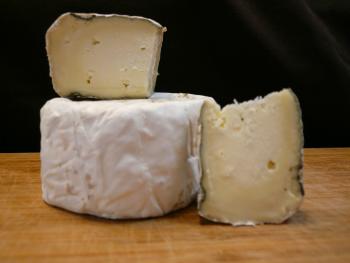St. Pat
- Producer
- Cowgirl Creamery
- Country
- United States
- Region
- California
- Size
- 4 ins diameter, 2 ins high
- Weight
- 10 oz
- Website
- www.cowgirlcreamery.com
- Milk
- Cow
- Classification
- Soft
- Rennet
- Microbial
- Rind
- Mold Ripened
Leaf Wrapped

Cowgirl Creamery, based in Marin County, California is the vision of owners Sue Conley and Peggy Smith.
Friends since college days on the east coast, they moved to California together in the 1970's, and, since both women were passionately interested in the food business, Peggy went to work at Chez Panisse in Berkeley with Alice Waters, while Sue became co-owner of the famous Bette's Ocean View Diner.
Twenty something yars later in 1993, Sue sold her part of the business in order to form Tomales Bay Foods, a business designed to provide a marketing outlet for local agricultural food products in Marin County. Discovering that her new company was fulfiling a tremendous need and niche, Sue asked Peggy to join her in launching a greatly expanded business, including a permanent farm-market type store selling locally made food products and a cheesemaking operation. The cheesemaking business and retail stores became known as Cowgirl Creamery.
The business flourished, and it quickly became clear that the cheese retail, wholesale and cheese making operations were the most successful. Today, Cowgirl Creamery has additional retail stores in San Francisco and Washington DC together with a much larger cheesemaking operation and warehouse based in Petaluma, CA.
Cowgirl Creamery, under the guidance of head cheesemaker Maureen Cunnie, produces a range of fresh and mold ripened cheeses using organic cow's milk from small local dairies.
Production of St. Pat takes place seasonally, during the Spring and early summer months. It is named St. Pat because, traditionally in West Marin, the cows are let out of their winter barn accomodation on St. Patrick's Day - March 17th, which is when the cheese becomes available.
Nettles are harvested locally in Bolinas, at Fresh Run Farm, blanched briefly for sterilization and to de-sting them, and then applied to the young cheeses.
Over the course of the next two weeks, St. Pat develops a light coat of white candidum mold over the top of the nettle leaves.
Flavors of the St. Pat are rich (due to the fresh, spring whole milk) and vegetal. Aromas are rich and buttery with herbaceous overtones. Very accessible, mild and yet full flavored.



